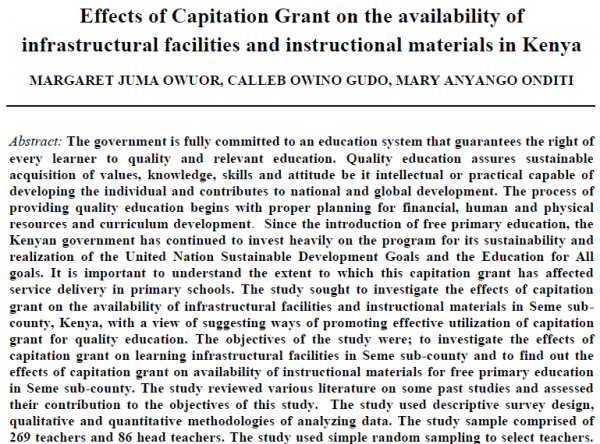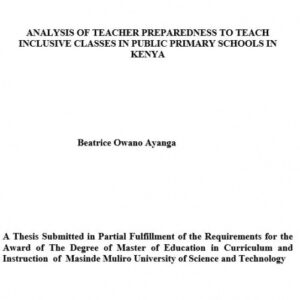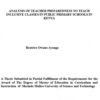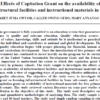Abstract: The government is fully committed to an education system that guarantees the right of every learner to quality and relevant education. Quality education assures sustainable acquisition of values, knowledge, skills and attitude be it intellectual or practical capable of developing the individual and contributes to national and global development. The process of providing quality education begins with proper planning for financial, human and physical resources and curriculum development. Since the introduction of free primary education, the Kenyan government has continued to invest heavily on the program for its sustainability and realization of the United Nation Sustainable Development Goals and the Education for All goals. It is important to understand the extent to which this capitation grant has affected service delivery in primary schools. The study sought to investigate the effects of capitation grant on the availability of infrastructural facilities and instructional materials in Seme sub-county, Kenya, with a view of suggesting ways of promoting effective utilization of capitation grant for quality education. The objectives of the study were; to investigate the effects of capitation grant on learning infrastructural facilities in Seme sub-county and to find out the effects of capitation grant on availability of instructional materials for free primary education in Seme sub-county. The study reviewed various literature on some past studies and assessed their contribution to the objectives of this study. The study used descriptive survey design, qualitative and quantitative methodologies of analyzing data. The study sample comprised of 269 teachers and 86 head teachers. The study used simple random sampling to select teachers. Purposive sampling was used to select primary school head teachers. Data was collected by use of questionnaire and interview schedules. Coded data was presented using Statistical Package for Social Sciences (SPSS) version 22 and analyzed using descriptive statistics such as percentages presented in tables. The study found that through the provision of FPE capitation grants, public primary schools were able to repair and maintain their learning facilities such as classrooms, desks and toilets, to improve the environment for teaching and learning. The study also found that FPE capitation grant has facilitated the availability and adequacy of instructional materials hence encouraged quality learning among the pupils. The study concluded that capitation grants influenced positively the availability of infrastructural facilities and instructional materials. Therefore the study recommends that due to effectiveness of FPE capitation grant, disburses on termly basis of 50% term one, 30% term two, 20% term three should consider adjusting upwards the amount awarded to schools to enable the school managers work effectively including proper maintenance of school infrastructural facilities and instructional materials. The school managers should be trained on proper financial management to prevent wastage and mismanagement of the funds. The school stakeholders should work in collaboration when it comes to identifying and budgeting for the learning materials to be purchased. This is important to ensure that the relevant materials with highest impact for the individual school are bought.
Key Words: Capitation grants, Infrastructural facilities, Instructional materials, Quality education






Reviews
There are no reviews yet.